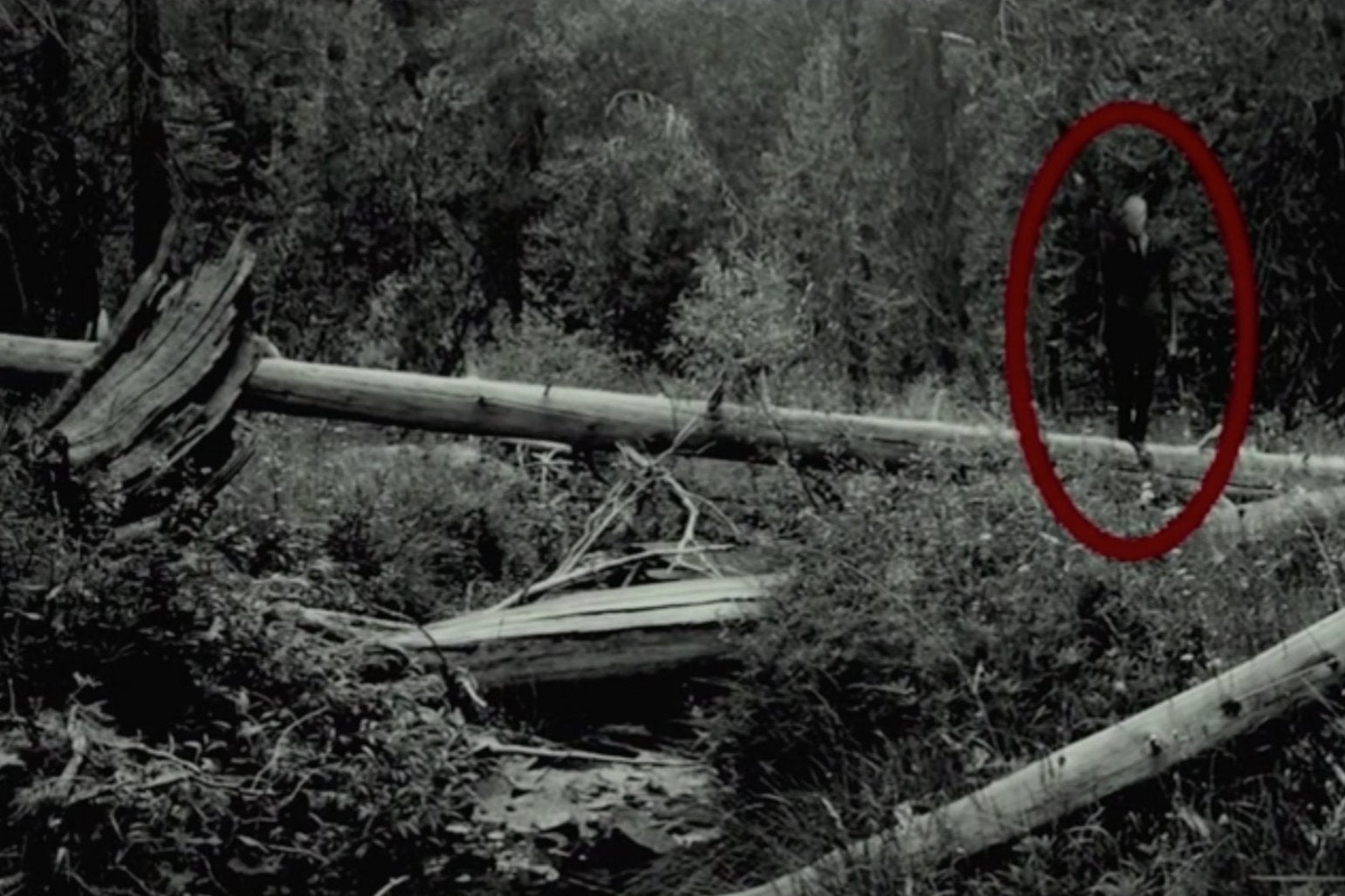Slender Man: A myth of the digital age
A true example both of the most wondrous and most destructive parts of the internet
It’s inevitable that the modern-day boogeyman would live on the internet. As birthed by forums, fan art, and shaky YouTube footage, the Slender Man is a startling example of modern-day mythmaking. His form is deep-rooted in tradition and folklore: a spirit of the woods, he’s largely characterised as a claimer of young souls.
He appears as a tall figure with overstretched limbs and dressed in a black suit, faceless. He has no motivation. He cannot be placated. And to witness him often brings its own death sentence.
When any phenomenon arises, of course, Hollywood is keen to cash in. With the myth first materialising in 2009, it’s a little surprising to see that it’s taken until now, and Sony’s Slender Man, for it to finally skulk onto the big screen.
It’s a story primed for the medium, especially in the context of its popularity within the world of “copypasta”: small, easily digestible stories whose viral appeal is reliant on shock twists and intriguing hooks.
These are stories, also, that have the potential to be endlessly manipulated and reimagined – a key ingredient in mythmaking, although the peculiarity of Slender Man is that, thanks to the nature of the internet, each of these retellings have been preserved; creating a digital trail that can trace the myth straight back to its originator. And to a single author: Eric Knudsen.
Under his username “Victor Surge”, Knudsen created the Slender Man in 2009 as part of a photoshop challenge on the Something Awful forum, in which users were asked to manipulate real photos to give them a paranormal edge. Knudsen submitted two examples, both black-and-white shots of children with a haunting, spectral figure in its background.
One caption read: “‘We didn't want to go, we didn't want to kill them, but its persistent silence and outstretched arms horrified and comforted us at the same time…’ — 1983, photographer unknown, presumed dead.”

The other read: “‘One of two recovered photographs from the Stirling City Library blaze. Notable for being taken the day which fourteen children vanished and for what is referred to as ‘The Slender Man’. Deformities cited as film defects by officials. Fire at library occurred one week later. Actual photograph confiscated as evidence.’ — 1986, photographer: Mary Thomas, missing since June 13th, 1986.”
Knudsen’s creation was immediately arresting, a perfect combination of Stephen King’s flair for mystery (his direct inspiration was “That Insidious Beast” from The Mist) and H.P. Lovecraft’s Gothic sensibility.

Watch Apple TV+ free for 7 day
New subscribers only. £8.99/mo. after free trial. Plan auto-renews until cancelled.
ADVERTISEMENT. If you sign up to this service we will earn commission. This revenue helps to fund journalism across The Independent.

Watch Apple TV+ free for 7 day
New subscribers only. £8.99/mo. after free trial. Plan auto-renews until cancelled.
ADVERTISEMENT. If you sign up to this service we will earn commission. This revenue helps to fund journalism across The Independent.
Knudsen’s initial post was built on, as more details of the Slender Man’s nature and history were created by fellow users. From there, it exploded into a massive process of collective storytelling.
The Slender Man had become a viral sensation. There are infinite variations of the myth (Wired alone estimated the digital art-hosting site DeviantArt holds more than 113,000 sketches of Slender Man), with several major conflicting attributes: sometimes he has tentacles, sometimes not.
At times his victims are solely children, becoming more reminiscent of traditional folkloric beasts and faeries, at other times he stalks teenagers in true urban legend style.
However, there have been two major forces (possibly three, if the Slender Man film makes enough of a mark) that have significantly helped to shape the Slender Man myth. The first is a freeware survival horror titled Slender: The Eight Pages, released in 2012, which drops players into the middle of a dense forest with only a flashlight to defend themselves with.
The objective, should you dare, is to collect all eight pages spread across the map without locking eyes with the Slender Man himself, who has a tendency to suddenly appear at the most inconvenient of times. It was downloaded over 2 million times in its first month of availability. A sequel titled The Arrival was released in 2013.
The second greatest influence on the Slender Man myth is Troy Wagner and Joseph DeLage’s YouTube series Marble Hornets. The channel’s 87 episodes have amassed over 96 million views.
Told through found footage, its story concerns itself with a young man who investigates the mysterious circumstances surrounding an unfinished student film, only to become a target for a figure known as “The Operator” – who appears as a clear iteration of the Slender Man.
A film adaptation, titled Always Watching: A Marble Hornets Story, was released in 2015, with The Shape of Water’s Doug Jones in the role of “The Operator”.
In 2014, the Slender Man broke out of internet culture, and into the wider consciousness, but only under the most tragic of circumstances. In Waukesha, Wisconsin, two 12-year-old girls stabbed their friend 19 times, later telling police it was under the orders of Slender Man.
They were picked up by law enforcement as they attempted to trek to the Nicolet national forest, convinced they would find his home there. Both girls were sentenced to mental institutions, with one eventually diagnosed with early-onset schizophrenia.
Since then, the Slender Man’s legacy has been a complex one. It’s an example both of the most wondrous and most destructive parts of our digital age: of how digital mythmaking has created a whole new collective force of imagination and ingenuity, while further blurring the line between fact and fiction, as has always been the danger of the myth’s hazy origins.
Slender Man is out now.